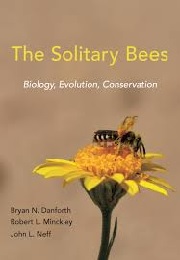The Solitary Bees

Bryan N. Danforth, Robert L. Minckley, John L. Neff and Frances Fawcett
Princeton University Press, £38.00
Contrary to popular belief most bees are lonely creatures. While industrial honeybees or charismatic bumblebees often take centre stage in our minds, the majority of the estimated 20,000 bee species around the world are solitary. The Solitary Bees is a celebration of the remarkable biodiversity, behaviour, and life histories of these often-forgotten bees.
The book starts by describing the phylogeny and life cycle of different solitary bees. The weird world of solitary bee courtship is discussed: who knew that some male bees collect floral perfumes to attract a mate? The nesting habitats of different solitary bees are described, and we learn about the life histories of parasitic cuckoo bees that will attempt to usurp hard working solitary bees. The book finishes by discussing the importance of solitary bees for agricultural and wild eco-systems and highlights some of the main threats to solitary bees such as loss of habitat and agrochemical exposure.
This book is a celebration of the lives of the often-unnoticed solitary bees and, as the authors state themselves, provides a roadmap for future research on bee biology. As biologists we are becoming increasingly aware of global insect declines, and urgent action is required to reverse these trends around the world. We cannot protect a species from extinction if we know nothing about it. The importance of this book for the field of bee biology cannot be understated.
Dr Harry Siviter


